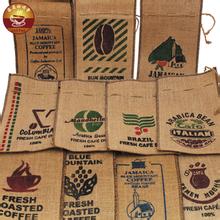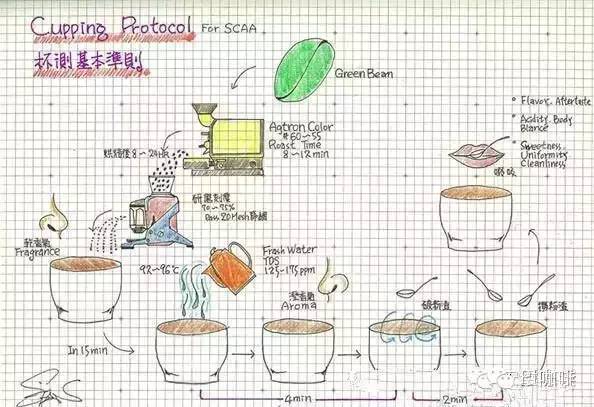Introduction to the packaging of coffee beans, the materials used in packaging and the differences in color
According to the form of coffee supply, coffee packaging can be divided into three categories: raw bean export packaging, roasted coffee bean (powder) packaging, instant coffee packaging.

Ethiopia Maral Coffee Packaging Atlas 1. Raw bean export packaging:
Raw beans are generally packed in gunny bags. Different coffee producing countries around the world usually export coffee beans in sacks of 70 kilograms or 69 kilograms (only Hawaiian coffee is packed in 100 pounds). In addition to the names of the country and its coffee organizations, coffee production units, and producing areas, the coffee sacks will also print the most typical patterns of their own countries on the sacks. These seemingly ordinary commodity sacks, in the eyes of coffee fans, has become a footnote to explain the background of coffee culture. It has even become a collection of many coffee fans, and this kind of packaging can be called the original packaging of coffee.
2. Roasted coffee beans (powder) packaging:
Roasted coffee beans (powder) packaging is the most diverse form of coffee packaging, because coffee beans will naturally produce carbon dioxide after roasting, direct packaging is easy to cause packaging damage, and long-term contact with the air will cause aroma loss and lead to the oxidation of oil and aromatic components in coffee resulting in quality decline. Therefore, the packaging of coffee beans (powder) is particularly important, which is generally divided into bagged and canned.
(1)。 Bagged:
Bags are generally divided into: non-airtight packaging, vacuum packaging, one-way valve packaging, pressure packaging.
Non-airtight packaging:
It is actually a temporary package that is only used for short-term storage.
Vacuum packing:
Roasted coffee beans need to be placed for a period of time and then packaged to prevent carbon dioxide damage to the packaging, which can be stored for about 10 weeks.
One-way valve packaging:
Adding an one-way valve to the bag allows the carbon dioxide produced to be removed but will block the entry of external gas, ensuring that the coffee beans are not oxidized but not preventing the loss of aroma. This kind of packaging can be stored for up to 6 months. There are also some coffee using exhaust hole packaging, that is, only making exhaust holes on the bag without adding an one-way valve, so that once the carbon dioxide produced by coffee beans is emptied, the external air will enter the bag, resulting in oxidation, so its storage time will be greatly reduced.
Pressure packing:
The coffee beans are vacuum packed and sealed with inert gas soon after they are roasted. This kind of packaging ensures that the coffee beans are not oxidized, the aroma is not lost, and the packaging is strong enough to ensure that the packaging will not be damaged by air pressure and can be stored for up to two years.
(2)。 Canned:
The cans are generally of two types: metal and glass, all of which are equipped with plastic lids for easy sealing.
3. Instant coffee packaging:
Instant coffee packaging is relatively simple, generally using sealed small bags, mainly in long strips at present, and there will also be outer packing boxes. Of course, there are also some canned instant coffee on the market.
Coffee bags-second, the materials of different kinds of coffee packaging are also different, the general raw bean export packaging material is relatively simple is the ordinary sack material. Instant coffee packaging also has no special material requirements, basically using general food packaging materials. The coffee bean (powder) packaging due to anti-oxidation and other requirements generally use opaque plastic composites, as well as more environmentally friendly Kraft paper composites.
Coffee bags-third, the color of coffee packaging also has certain rules, according to the practice formed in the industry, the color of finished coffee packaging reflects the characteristics of coffee to a certain extent:
Coffee packaged in red usually tastes thick and allows drinkers to quickly wake up from last night's good dream.
Black packaged coffee, belonging to high quality small fruit coffee
Golden packaged coffee, symbolizing wealth and wealth, indicates that it is the best coffee.
Coffee packaged in blue is usually "non-caffeinated".
Coffee is one of the three largest soft drinks in the world, and it is the second largest trading product in the world after oil. Its popularity is evident. And the coffee culture contained in its packaging is also charming because of its long-term accumulation.
Source:
Important Notice :
前街咖啡 FrontStreet Coffee has moved to new addredd:
FrontStreet Coffee Address: 315,Donghua East Road,GuangZhou
Tel:020 38364473
- Prev

Packaging of coffee beans: what bag is the most suitable for packaging coffee beans?
Coffee bags can choose to use environmentally friendly materials, such as linen bags, cotton bags. General conventional packaging, especially overseas merchants like to use yellow linen to package. Jute is not only environmentally friendly and recyclable, but also can be printed with a variety of logos. Beautiful and practical. Since coffee beans naturally produce carbon dioxide after roasting, direct packaging is easy to cause packaging damage.
- Next

Technical Identification of Coffee: how to distinguish Coffee-introduction of Cupping Cup Test
After the coffee bean is roasted, the baker will make a simple and effective evaluation of it. This kind of evaluation is called cupping. Cup test is an important link to evaluate the baking quality and taste performance of coffee beans. It allows us to distinguish the nuances of coffee beans when they are roasted, and allows us to deduce the quality of raw coffee beans. The cup square method moves together.
Related
- What is the meaning of lactic acid fermentation with coffee bean treatment?
- How to judge the state of foam by sound?
- How does the latte pull out the unicorn pattern? Come to get for a little trick to improve the flower pull!
- Will flower pulling affect the taste of the latte?
- Do you know the history of coffee?
- The difference between honey treatment and sun washing what is raisin honey treatment?
- What kind of milk can a novice use to make coffee foam to keep the foam longer? The correct method and skills of milking tutorial sharing
- Why do washed coffee beans taste sour? Flavor characteristics of washed Coffee
- Introduction to the skill of how to practice the size and height of water injection around the circle of hand-brewed coffee
- How do beginners practice coffee flower drawing from scratch?

